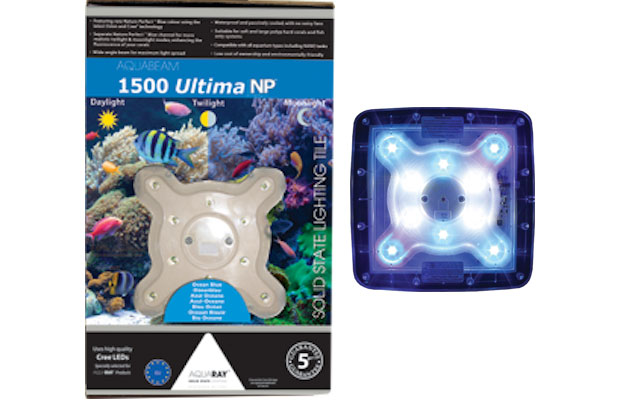The AquaBeam Ultima 1500 NP is the newest LED tile from Tropical Marine Centre which upgrades its light emitting diodes both in performance but more substantially in color balance. Until the AquaBeam Fiji Blue LED strip was introduced, we felt that the TMC LED line was seriously lacking the true royal blue LED colors that are some of the most highly sought after, especially here in the United States.
The Ultima 1500 NP LED tile includes Cree’s latest and greatest XT-E chips with 6 diodes spread across four cool white (which TMC calls ‘Ocean White’) and two royal blue (which TMC calls ‘Fiji Blue’) But perhaps the most notable addition to the AquaBeam Ultima 1500 NP is the use of the very well received Osram Olson Deep Blue LEDs which TMC also has a made-up name for – “Nature Perfect”.
We may hold a modicum of disdain for the confusing renaming of known LED colors and bins that TMC is practicing, but we can see how some manufacturers would want to align customer’s expectations of colors with familiar colors of T5 lamps. marketing criticisms aside, the more progressive and familiar ratio of actual royal blue, deep blue and cool white LEDs is sure to please a lot of the California-style reefers.
In fact, the new expected color balance of the AquaBeam Ultima 1500 NP with its 30 watts of current generation brand name LEDs is probably TMC’s best LED light for the current taste in coral growing light. With no lenses the three colors of LEDs should blend pretty well and the small package should be well received at the advertised price of $259, although you’ll need a separate controller to take advantage of the two color channels. [AquaRay USA]
Update: We already got a little tip from TMC letting us know about the origin of the “Nature Perfect” LED
The nature perfect diode is in fact not [just] a deep blue. This is actually a bit of a special diode. It is a blue chip with a very small amount of phosphor applied to allow for three things: A more realistic moonlight when used on its own (i.e. not overly blue – the two royal blues ensure great coral fluorescence too), broader and therefore more useful spectrum, brighter look to the human eye. We spent a lot of time playing about with various colour combinations to get to this point and we’re quite proud of the outcome.



